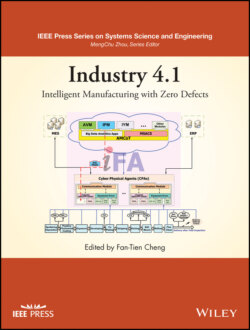Читать книгу Industry 4.1 - Группа авторов - Страница 41
Sensor Selection and Installation
ОглавлениеWhen it comes to selecting appropriate sensors for monitoring a specific machining process, the cutting force is regarded as the best indicator to describe the performance of cutting processes and determine product quality. Five commonly used sensors for capturing cutting‐force information are listed in Table 2.1.
Table 2.1 Sensor comparison.
| Physical quantity | Measuring type | Detecting principle | Typical device | Cost | Intrusive nature |
|---|---|---|---|---|---|
| Force | Direct | Deformation | Strain gauge | High | High |
| Current | Indirect | Hall effect | Current transducer | Low | Low |
| Speed | Indirect | Displacement | Accelerometer | Medium | Medium |
| Temperature | Indirect | Seebeck effect | Thermal couple | Low | Medium |
| Sonic | Indirect | Radiation of elastic wave | Acoustic emission transducer | High | Medium |
The other critical issue for selecting a proper sensor type is the sampling rate, which represents the scanned frequency per second for reading data from sensors that have to provide clear, continuous enough, and distortion‐free data.
To make signals distortion‐free, the Nyquist–Shannon sampling theorem states that the sampling rate for signal Fs is at least more than twice the highest frequency FB component contained in the acquired signals during machining processes so that no information gets lost by discretization [6–8]. The relationship can be defined as Fs > 2FB.
In the past, the sampling rate is restricted by the hardware specification and cost. As hardware becomes faster and cheaper, in a modern monitoring system, the sampling rate can be set at a very high frequency (>10 k Hz) to ensure that captured signals are nondistorting and can represent any situation during production since the sensor can serve as an independent unit from the manufacturing tool or device, which means that they do not decrease the production performance or disturb the machining process. However, a high Fs generates a high‐dimensionality of data size, which makes raw data hard to be used directly. Some signal processing techniques for simplifying the data will be introduced in Section 2.3. In the following, several types of sensors, such as force: strain gauge, loading: current transducer, vibration: accelerometer, temperature: thermal couple, and AE waves: AE transducer, are introduced and followed by the description of sensor fusion.
